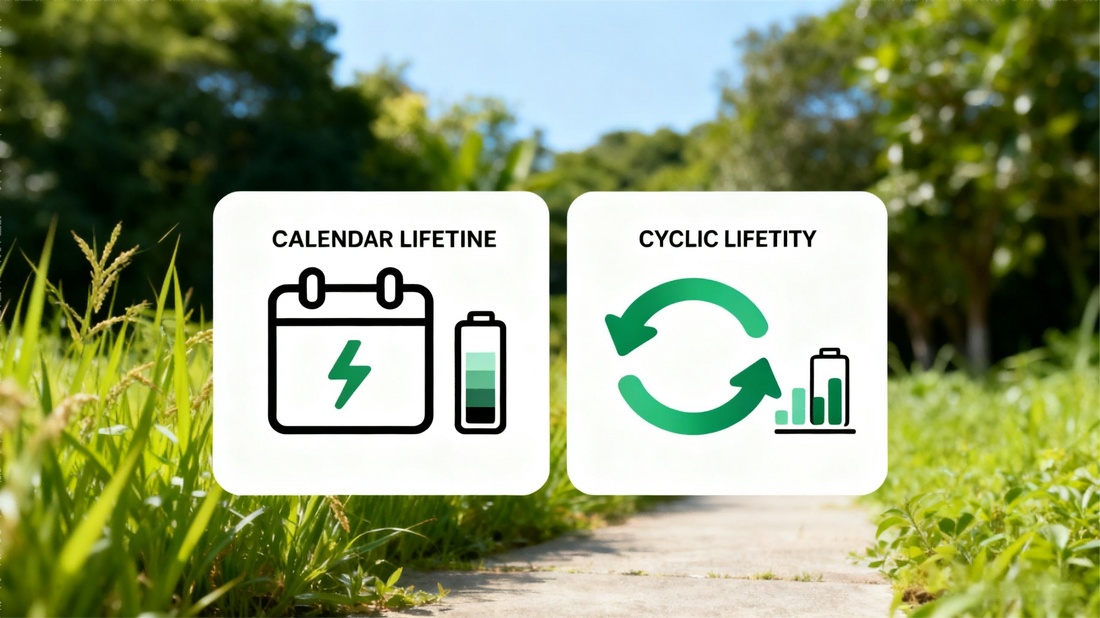When discussing electric vehicle (EV) or home energy storage batteries, the most frequently touted spec is "cycle life"—for example, "80% capacity remaining after 6000 charges." This creates an illusion that a battery's lifespan is determined solely by how many times you use it.
But the reality is far more complex. The ultimate fate of the lithium battery in your device is decided by two silent, parallel-operating forces: one named Cycle Life, and the other, Calendar Life. Understanding them is the key to making smart choices.
Part 1: Meet the Two Forces Shaping Your Battery's Destiny
Cycle Life: The Wear and Tear from Use
-
Definition: This refers to the number of complete charge and discharge cycles a battery can undergo before its capacity significantly degrades. Think of it like a pencil: how many words it can write depends on how many times it's sharpened.
-
A "cycle" is counted based on cumulative use. For instance, going from 0% to 100% and back to 0% counts as one full cycle. Similarly, going from 50% to 100% and back to 50% counts as half a cycle.
-
-
The Industry Standard: A common benchmark in the industry is when a battery's capacity fades to about 70% of its original state. At this point, it's often considered to have reached its effective "end of life" for its primary purpose, as performance (like EV range) becomes noticeably compromised. It's important to note this is a guideline, not a hard rule—you can choose to keep using a degraded battery if it still meets your needs.
-
Influencing Factors: Depth of discharge, charge/discharge rate, and temperature. Every cycle inflicts minor, cumulative wear on the battery's internal structure.
Calendar Life: The Inevitable March of Time
-
Definition: This is the total time from a battery's manufacture until its capacity falls below a specified threshold, even if it's never used. Calendar life is like a food's expiration date; regardless of how much you eat or how carefully you store it, it will eventually go bad.
-
Influencing Factors: Time, ambient temperature, and the charge level during storage. This is an intrinsic chemical process where the electrolyte and electrode materials slowly undergo irreversible side reactions.
Part 2: Why Can't Lithium Batteries Last Forever? The 4 Key Degradation Mechanisms
So, what's happening inside your battery that causes this gradual decline? Four silent killers are at work:
1. The SEI Layer: A Double-Edged Sword
-
A protective layer called the Solid-Electrolyte Interphase (SEI) forms on the anode (negative electrode). Think of it as a protective "jacket" that prevents further reaction between the anode and electrolyte (similar to the passivation of metals in strong acids).
-
However, this "jacket" slowly thickens with each charge cycle. This growth permanently consumes active lithium ions—the very particles essential for storing and releasing energy. This is an unavoidable cause of daily capacity loss.
2. Lithium Dendrites: The Silent Hazard
-
Under conditions like fast charging or low temperatures, lithium ions can clump together, forming needle-like structures called dendrites.
-
They are harmful in two ways: First, they trap and consume active lithium, reducing capacity. Second, if they grow long enough, they can pierce the separator (the battery's internal "firewall"), potentially causing a short circuit and raising safety concerns. Fortunately, dendrite growth can be mitigated with proper care.
3. Separator Degradation: The "Shrinking" Crisis
-
The separator is a micro-porous plastic film that keeps the positive and negative electrodes apart to prevent shorts, while allowing lithium ions to pass through.
-
However, prolonged exposure to high temperatures (e.g., leaving a phone in a hot car or charging an EV in extreme heat) can cause the separator to degrade and shrink. This increases internal resistance, leading to slower charging, reduced range, and overall performance decline.
4. Electrolyte Decomposition: The Drying "Bloodstream"
-
The electrolyte is the conductive medium that allows lithium ions to shuttle back and forth. However, a small amount of electrolyte decomposes during every single charge and discharge cycle.
-
It's like a slow evaporation process; the electrolyte gradually depletes and its composition changes. This leads to a drop in voltage and a steady shortening of runtime, inevitably cutting the battery's lifespan. Like SEI growth, this is an unavoidable process.
Part 3: 4 Practical Tips to Extend Your Battery's Service Life
While you can't stop degradation completely, you can significantly slow it down with these four habits:
1. Avoid Full Charges and Deep Discharges: The 20-90% Sweet Spot
-
Don't routinely run your battery down to 0% or leave it plugged in at 100% for long periods. These extremes stress the battery and accelerate the loss of active lithium. For daily use, try to start charging around 20% and unplug once you reach about 90%.
2. Prioritize Slow Charging Over Fast Charging
-
While incredibly convenient, fast charging forces high currents into the battery, generating heat and promoting lithium dendrite growth. For daily top-ups at home or the office, use a standard AC slow charger whenever possible. Reserve DC fast charging for when you're truly in a hurry.
3. Keep It Cool, Especially When Charging
-
Avoid charging devices in direct sunlight or hot environments (like a car on a summer day). If a device feels hot to the touch during charging, unplug it and let it cool down first. Heat is a primary accelerator of all degradation mechanisms.
4. Be Wary of Fast Charging in Cold Weather
-
Lithium ions move sluggishly in the cold. Fast charging a cold battery dramatically increases the risk of lithium plating and dendrite formation. In temperatures below 0°C (32°F), try to use a slow charger to "wake up" the battery first, or bring the device to a warmer temperature before using a fast charger.

